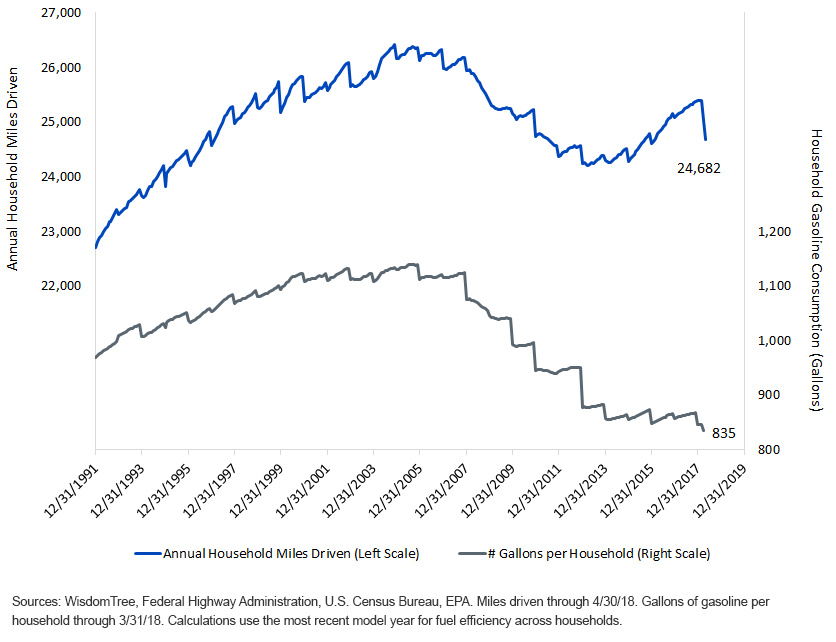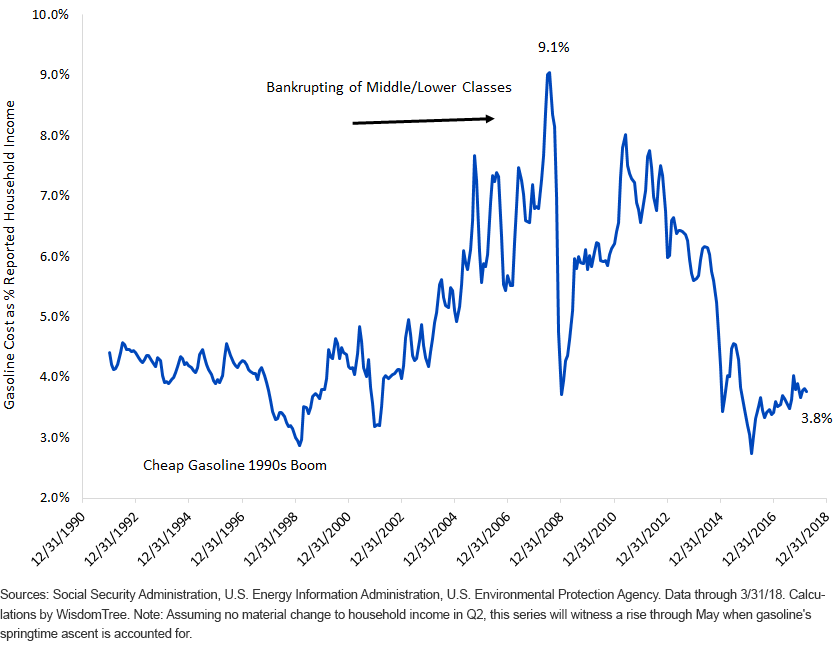When $80 Crude Oil Doesn’t Feel Like $80 Crude Oil


“Judging by the oil market in the pre-OPEC era, a ‘normal’ market price might now be in the $5-10 range. … Last week Algeria’s energy minister declared, with only slight exaggeration, that prices might conceivably tumble ‘to $2 or $3 a barrel.’”
—The Economist, March 4, 1999
That feels like a million years ago. A decade later, straight-faced economists would be talking about $200 or $300. Times change.
With oil two years along in a bull rally that has witnessed its price triple from the Q1 2016 lows, it may be just a matter of time before the purported list of stock market obstacles starts to include retail gasoline pain. With West Texas Intermediate Crude oil changing hands at $71.68 and Brent Crude at $79.65, it’s hard not to be scared off by our society’s ups and downs at the gas station.1
After regular unleaded challenged $4 a gallon, $3.695 to be precise,2 in summer 2014, many strategists began to fear the worst. Gasoline would once again deal the deathblow to the middle and lower classes, as it had a half decade prior.
But 2014 marked the worst of it, at least for now. WTI crude oil collapsed from triple digits to less than $30 in early 2016. Retail gas followed along, to levels south of $1.80.
But it has quietly chipped back, closing Q1 at $2.57, and at $2.95, three dollars looms in our collective psyche.3 People remember the first time they saw a gas station post $1, then $2, then $3. And at $4, that memory strikes the gut: the insolvency years.
Tie the threat of $3 national average gasoline, maybe sooner than the Labor Day road trip, with the possibility that Federal Reserve (Fed) Chairman Jerome Powell may bring two or three more rate hikes of 25 basis points (bps) by this year’s close, and it is not much of a leap to be sympathetic to a thesis of a gasoline-induced blow to consumer confidence. But be careful, because that thesis is flawed.
Whispers
The “whisper number” on Saudi aspirations for Brent Crude is $80 to $100 per barrel. But Donald Trump was already tweeting angrily at $70 a barrel, so it is reasonable to assume that another $10 to $20 would unwind much progress on recently fruitful U.S.-Saudi relations. But suppose ROPEC—Russia plus OPEC—marks oil up to $100 anyway. Gasoline could be closer to $4 than $3 in that circumstance. Does that break the American consumer? A half generation or a generation ago, yes—certainly. But psychological anchoring on round numbers like $100 or $3 deceives. Consider our analysis below.
Our 2018 Reality
Figure 1 places unleaded gasoline costs in context. The U.S. population of some 322 million people consists of 126 million households driving more than 3 trillion miles per year. But because millennials do not drive as much as their predecessors, the number of auto miles driven per household has fallen to fewer than 25,000 from a peak of 26,413 in 2004.
Additionally, today’s cars are essentially computers on wheels, and fuel efficiency is notably higher than it was in prior years.
Twenty years ago, the new car fleet got 23.4 miles to the gallon.4 By 2008, it was virtually unchanged, at 24.3. But America got burned on triple-digit oil prices, making it somewhat politically palpable when the Obama administration pushed forward with mandated 54.5 mpg fuel economy targets for model year 2025. In pursuit of such efficiency, the new car fleet’s efficiency rose to 30.0 mpg for the 2017 crop.
For the math in figure 1, we make the leap that every household owns the latest model year automobile, which of course they do not. Using that concept for illustration, households of yesteryear were using 1,100 gallons of gasoline per year. The figure has been in fortunate free-fall because of reduced auto usage and fuel efficiency, and it now stands at just 835 gallons per household.5
Figure 1: U.S. Household Auto Usage

Frankly, $3 gasoline doesn’t have the same bite as it once did. Using wages reported to the Social Security Administration and our calculation of the number of income earners in each household, we find that the typical home is currently reporting to the tax authorities $57,122 from all earners. That is up from $44,952 at the beginning of this decade, because millions of laid-off workers now have earned income again and because wages have gently risen, albeit at a crawling pace.
Figure 2 shows the stark contrast between what gasoline meant to Americans at the apex of the “commodities supercycle” and what it means to them today. In mid-2008, when the average household had $48,213 in Social Security earnings, people driving late-model cars that got 24.1 mpg were gobbling 1,067 gallons of gasoline at $4.09 a gallon. That was 9.1% of every dollar that flowed into households.
Today, a sharp contrast. If the same households are driving today’s late-model vehicles, which get 30 mpg, not only are they driving less, but the vehicles don’t have to fill up as frequently. Their gas consumption has fallen 19.7% in one decade, they earn about $9,000 more and the price itself is still south of $3. Current gasoline expenditure is just 3.8% of the earnings regular households are reporting to Uncle Sam, an amount that is akin to the cheap gasoline era of the booming 1990s.
Figure 2: Gasoline as % Household Income

By any standard of modern history, the gasoline price would have to spike another dollar, maybe even two—and do so rapidly because of the fuel economy arms race—before Middle America feels a pinch anything like the old days. Whether $70 or $80 a barrel is high or low is another issue. If the question is whether regular people are being crushed by gas right now, or at $100 oil, the answer appears to be “no.”
1Source: Bloomberg, 5/23/18.
2All gasoline price references sourced from the EIA, April 2018 Monthly Energy Review.
5Calculations by WisdomTree using federal government data through 3/31/18.


